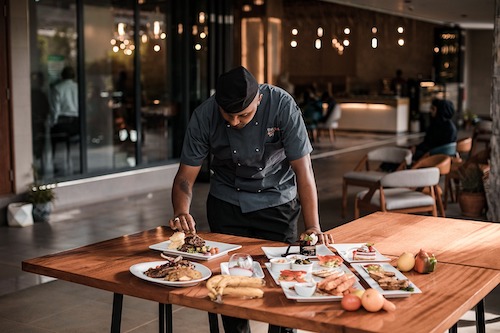
Eight Food Trends for Hoteliers to Consider
By David Berman | June 22, 2023
The world of food is always shifting. For hotels, it’s important to stay cognizant of the latest and greatest so that you can figure out how these trends will impact revenues or potentially affect costs.
And while you may not be directly involved in F&B, the reason that we believe all hoteliers should consider food service excellence is due to the “halo effect.” From your perspective, F&B is a discrete operation, possibly even third-party-managed to maintain an overhead-light operating model. But from the guest’s perspective, it’s all one experience blended together. For instance, a great dinner raises the mood to reflect positively on how the guest room is perceived.
Hence, staying at the forefront of food trends is critical. So, here are eight to think about.
- Tea: Who would’ve thought, right? Most F&B outlets pride themselves on their coffee service, but tea offers a tremendously diverse selection by which to enhance the meal experience. There are the caffeinated blends, or single origin versions, of green, white, black, oolong and orange, but when designing a modern tea program there is now much more appreciation for high-end herbal and functional blends.
- Generation Zilch: This is a new nickname for the late-millennial and centennial cohorts that is gaining steam as a way of describing their comparatively clean forms of vice. Whether driven by the economics of the times or awareness of the detrimental health effects, young people today are minimizing or abstaining from drinking regularly and smoking (even vaping). As alcohol is where the margins are, you need to start thinking of pivoting to other beverage enhancements like tea, mocktails, smoothies or restorative tonics. And while mentioning these often-unctuous tonics, the palates of younger generations have a significantly appreciation for spicy foods, as led by the sriracha craze, in addition to aromatic and highly marketable spice blends like five spice (China), shichimi (Japan), za’atar (Levant), baharat (Middle East) or garam masala (India).
- Zero Artificial Additives: A sub-movement within the healthy eating trend is a greater awareness for the slow-acting, harmful effects of unnatural food processing, coloring agents, emulsifiers and preservatives. Next time you’re at the grocery store, look on the back for things like potassium sorbate, carrageenan, polysorbate 80, autolyzed yeast extract or maltodextrin. Perhaps the biggest push right now is around removing industrialized seed oils like grapeseed, sunflower, soybean, corn, canola or, worst of all, hydrogenated vegetable oil (the science here is beyond scope, but they have been shown to be dangerous, especially when put under high heat). All told, there may soon come a day when your server puts a bottle of olive oil down on the table, only for the guest to ask if it’s been cut with a seed oil where any uncertainty in the response will yield scoffs of disgust.
- Cleaner Meats: Yes, people are edging more towards plant-based, flexitarian or plant-forward, but concurrently they are also asking restaurants for more literature about where they are sourcing their meats. Are your eggs free run, free range or pasture-raised? Is your fish certified as sustainably sourced? Is your butter grass-fed? Is your red meat grass-fed…and grass-finished? Do you list the exact farm where your animal products are from? Obviously, this level of detail will differ by restaurant and target audience, but these modifiers are still important for some customers. Importantly, they very often let you charge more.
- Lab-Cultured Meats: While plant-based meats are still gaining traction, there is another emerging alternative to factory-farmed animals where the science is paving the way. Currently, only Singapore legally allows for lab-made animal imitations to be sold direct to consumer, but it’s only a matter of time before this trend snowballs. Given the increasing costs of animal husbandry and the mounting awareness of the inhumane conditions for livestock on big factory farm, it’s only a matter of time before the FDA or other regulatory bodies start to seriously consider legalization.
- Invasivorism: An ‘invasivore’ is someone who seeks to eat animals or plants that are not indigenous to a given area (as opposed to a ‘locavore’). This is a form of climate activism whereby customers are helping support the reorientation of supply chains around the consumption of species that are harmful to the environment. In the United States, for instance, there’s a movement to try and get people to eat Asian carp which has had a destructive impact on the Mississippi river system.
- Regenivorism: Slightly newer than an invasivore, a regenivore denotes a person who selects foods specifically for their ability to help regenerate the local ecosystem. As a step beyond sustainable sourcing, regenivorism may involve the eating a product made from upcycled waste – for example, specialty mushrooms grown in compost. Herein you may be noticing the larger trend which is that climatarians are gaining ground as a more vocal minority of the population and environmentalism is only bound to grow in the coming years. Right now, it’s more about marketing cachet, but times may soon change as weird weather events become more frequent.
- Automation Always: To contend with ever-changing costs, digital menus are a boon as you can update pricing instantaneously and without the cost of reprinting menus. Moreover, restaurants need tech to contend with the temporal shifts to eating patterns resulting from remote work. These sorts of customer-facing and largely web-based improvements already abound to help speed up the ordering process and encourage more total spend per table. Hence, it’s important to always consider what else you can use your software for to ensure that your servers’ time is spent more productively by better servicing in-house guests. Then for the more futuristic-minded, we are seeing companies deploy ceiling-mounted robotic arms for food assembly. Call us crazy, but just in December McDonald’s debuted its first ‘mostly automated’ location in Forth Worth, Texas. Robots working in the kitchen will happen sooner than you think.





Get involved!
Comments